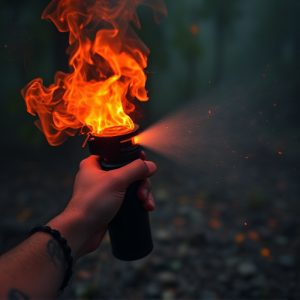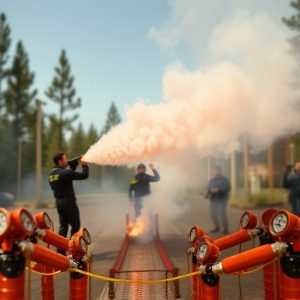Optimizing Law Enforcement Tactics with Wildfire Pepper Spray: A Guide for Effective Use and Crowd Management
Wildfire pepper spray is a crucial non-lethal tool in modern law enforcement for managing high-risk…….
Wildfire pepper spray is a crucial non-lethal tool in modern law enforcement for managing high-risk situations and maintaining public safety. Its highly concentrated oleoresin capsicum formula provides a deep penetration effect, affecting individuals over longer distances and for extended periods. Proper training is essential to ensure both officer and subject safety when using this advanced deterrent, which can be deployed in various forms such as foam rounds or direct sprays. Environmental factors like wind and weather must be considered for effective performance. Wildfire pepper spray serves as an alternative to lethal force in active assailant situations, crowd control, and personal defense. It incapacitates individuals by inducing a burning sensation that affects vision, breathing, and cognitive function, lasting from half an hour to several hours. Legal frameworks must support its use with clear guidelines and rigorous training for officers. Law enforcement agencies are tasked with continuously monitoring its effectiveness in real-world scenarios and staying updated on legal developments to maintain compliance and public trust. The strategic deployment of Wildfire pepper spray, alongside de-escalation tactics, is a key component of effective crowd management strategies. Regular training that includes understanding its chemical makeup, environmental considerations, and realistic simulations is necessary for officers to use this tool safely and effectively.
Law enforcement agencies face dynamic challenges, particularly when confronting unruly crowds or suspects. Wildfire pepper spray emerges as a potent non-lethal tool in such scenarios. This article delves into the multifaceted role of Wildfire pepper spray within the realm of crowd and riot control, offering insights into its efficacy and application. From understanding its composition to mastering its strategic deployment, our guide equips officers with the knowledge necessary for effective use of this versatile defense mechanism. We explore legal frameworks, practical training protocols, and real-world applications, ensuring that law enforcement professionals are well-prepared to handle situations where Wildfire pepper spray can be a decisive asset.
Understanding Wildfire Pepper Spray: A Comprehensive Guide for Law Enforcement
Wildfire pepper spray stands as a critical non-lethal tool in the arsenal of law enforcement, particularly when addressing volatile situations that could escalate into violence or where the preservation of life is paramount. This advanced formula, which has been rigorously tested and refined, delivers an intense dose of oleoresin capsicum (OC), a compound known for its debilitating effects on those who come into contact with it. Unlike traditional pepper sprays, Wildfire’s proprietary blend is designed to penetrate deeper through the nasal passages and respiratory system, effectively incapacitating individuals over greater distances and durations.
Law enforcement personnel must possess a thorough understanding of the capabilities and limitations of wildfire pepper spray to deploy it judiciously and effectively. The spray’s potency necessitates proper training in its use to ensure safety for both officers and subjects. When used correctly, it can serve as a significant deterrent during crowd management, active assailant incidents, or when subduing a combative individual without resorting to lethal force. Understanding the environmental factors that can affect its performance, such as wind direction and weather conditions, is also crucial for law enforcement to maximize the spray’s efficacy in various scenarios.
The Chemistry Behind Wildfire Pepper Spray and Its Effects on Perpetrators
Wildfire pepper spray is a non-lethal self-defense and crowd dispersal agent that harnesses the power of capsaicinoids derived from chili peppers. Specifically, it contains oleoresin of capsicum, which induces an intense burning sensation upon contact with mucous membranes or skin. This potent formulation is encapsulated within a pressurized canister, delivering a concentrated burst capable of incapacitating assailants. The chemistry behind this spray involves the interaction of capsaicin with the sensory neurons responsible for detecting noxious environmental stimuli. When deployed, it binds selectively to the TRVP1 receptor in the pain-sensing nerves, leading to an overstimulation that triggers an overwhelming sensation of heat and burning. This effect is not merely a nuisance; it severely impairs the perpetrator’s ability to function by affecting their vision, respiratory system, and central nervous system. The effects can last from 30 minutes to several hours, providing law enforcement with ample time to apprehend an individual without resorting to deadly force. Understanding the chemistry of wildfire pepper spray is crucial for its safe and effective deployment in various situations, making it a valuable tool in crowd management and personal defense scenarios.
Legal Considerations and Protocols for Deploying Wildfire Pepper Spray in the Field
When integrating wildfire pepper spray into law enforcement protocols, it is imperative to navigate the intricate web of legal considerations that govern its use. The deployment of such a potent irritant must be anchored in statutes and regulations that define its permissible use under various circumstances. Law enforcement agencies are tasked with establishing clear guidelines and training protocols to ensure officers understand the situational appropriateness and limitations of wildfire pepper spray. These guidelines should encompass scenarios where its application is justified, considering factors such as the threat level, the potential for collateral exposure, and the presence of vulnerable populations. Officers must receive comprehensive training that includes recognition of these factors and hands-on practice under simulated conditions to refine their decision-making processes and ensure compliance with legal standards. Furthermore, continuous oversight is necessary to evaluate the effectiveness of wildfire pepper spray in field settings and make any adjustments to protocols as needed, thereby upholding the integrity of law enforcement operations and maintaining public trust. Agencies must also keep abreast of legal amendments and case law that could influence the permissible use of this tool, ensuring their practices remain within the confines of the law at all times. Adherence to these protocols not only ensures the safety of both law enforcement personnel and civilians but also supports the effective integration of wildfire pepper spray into the broader scope of operational strategies for surveillance and crowd management in various settings.
Strategic Use of Wildfire Pepper Spray in Crowd Management and Riot Control Scenarios
Law enforcement agencies are increasingly relying on advanced non-lethal munitions to manage crowds and maintain public safety during civil unrest or riots. Wildfire pepper spray, a potent form of self-defense and crowd control, has emerged as an invaluable tool within this realm. Its high concentration of oleoresin capsicoid (OC) creates an immediate and powerful irritant effect upon contact with the eyes, skin, or respiratory system of individuals. When deployed strategically, such as through foam rounds or direct spray, it can effectively incapacitate subjects temporarily without causing long-term harm. This allows for the safe apprehension of suspects and de-escalation of potentially violent situations.
The effectiveness of Wildfire pepper spray in crowd management is underpinned by its range of applications and controlled delivery systems. In riot control scenarios, it can be deployed from a distance using long-range pepper spray projectiles, which reduces the risk to officers and bystanders. Its use can be tailored to the intensity of the situation, providing a scalable response option that ranges from crowd dispersal to targeted incapacitation. The ability to employ this tool in a measured manner, alongside other de-escalation techniques and procedural justice principles, contributes to the strategic management of crowds, ensuring public order is maintained with minimal use of force.
Training and Best Practices for Law Enforcement Officers Using Wildfire Pepper Spray
Law enforcement officers utilize Wildfire pepper spray as a non-lethal means for crowd control and personal defense due to its robust formulation and reliability in various situations. Proper training is paramount when deploying this tool, as its effectiveness is contingent on the officer’s skill and knowledge of its application. Officers should undergo comprehensive training that includes understanding the chemical properties of the spray, recognizing the wind conditions, and mastering the correct deployment techniques. This training ensures that law enforcement personnel can confidently use Wildfire pepper spray to subdue individuals without causing irreversible harm.
Best practices for using Wildfire pepper spray emphasize situational awareness and decision-making under pressure. Officers must be adept at assessing the threat level, the proximity of bystanders, and potential environmental factors like wind direction that could affect the spray’s trajectory. Continuous training exercises should simulate real-world scenarios to prepare officers for a variety of situations, reinforcing their ability to use Wildfire pepper spray effectively while minimizing risks to both the target subject and the general public. Regular drills with realistic mock adversaries help maintain proficiency and readiness in employing this tool within the scope of law enforcement operations.


